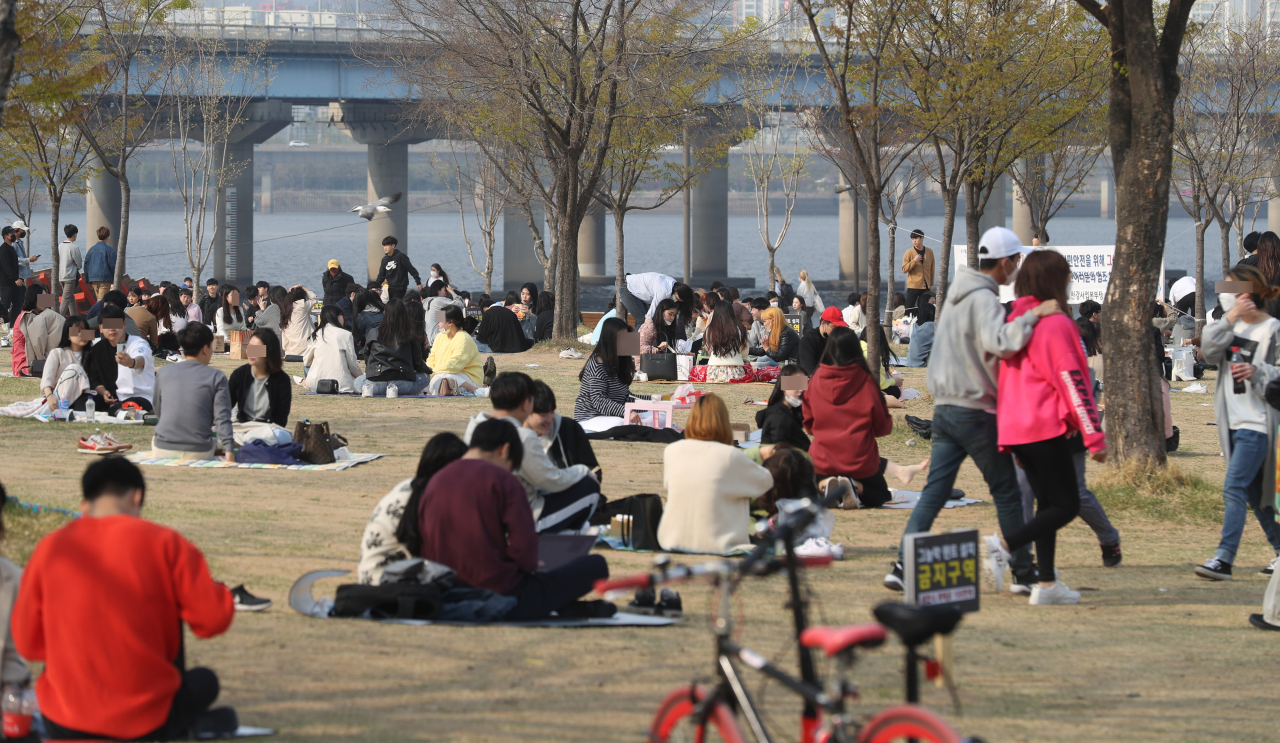S. Korea mulls extending ‘social distancing’
South Korea confirms 22 new cases Friday, hovering around 20 for the 5th day
By Ock Hyun-juPublished : April 17, 2020 - 18:31

The South Korean government is mulling over whether to extend its social distancing campaign to fight COVID-19, amid concerns over community spread following Wednesday’s parliamentary elections and the Easter weekend. The campaign was scheduled to end Sunday.
Despite the country’s tally of new cases of the novel coronavirus hovering around 20 for the fifth straight day, health authorities are on alert over a possible spike in new infections due to people’s increased movements and physical contact over the past week.
“There is a risk of community spread of the virus for a while after major events such as the Easter weekend and Wednesday’s parliamentary elections,” Yoon Tae-ho, a senior official from the Ministry of Health and Welfare, said at a briefing Friday. “We should be on high alert for the next one to two weeks.”
Given the incubation period of the virus, which can be two weeks or longer, there are concerns that this could lead to a surge in the number of new infections.
The government has considered transitioning to “routine distancing,” which would allow citizens to return to their normal routines while fighting the coronavirus in their daily lives, amid growing fatigue over the prolonged social distancing campaign.
There were two conditions that had to be met for this shift to take place: The country had to have fewer than 50 new infections per day, and the sources of infection had to be traceable in at least 95 percent of cases.
Those conditions have been met. Korea reported 22 new cases Friday, bringing the total number of infections to 10,635, with the number of new cases hovering around 20 for the fifth day. Some 3.1 percent of new cases for the past two weeks involved unidentified transmission routes.
The government is expected to announce a decision on whether to move to routine distancing this weekend after collecting opinions from experts, municipalities and citizens.
Yoon once again stressed that routine distancing also requires people to continue to stick to social distancing guidelines.
“Routine distancing is not a new concept that ignores the basic principles of social distancing. Even if we move to routine distancing, maintaining 1 to 2 meters of social distance is still necessary,” he said.
Korea’s rigorous social distancing campaign has been in place since March 22. The government urged the public to stay indoors and tightened restrictions on religious gatherings, as well as indoor sports facilities and entertainment establishments.
Due in large part to the restrictions, the country has managed to flatten the virus curve.
After reaching a peak Feb. 29 with 909 cases, the country has since managed to massively reduce the number of new infections. The number of daily new infections was below 50 for nine days in a row.
Of the new cases reported Friday, 11 came from overseas, all of which were detected at airport checkpoints, according to the Korea Centers for Disease Control and Prevention.
Of all patients, 7,829, or 73.6 percent, have recovered.
Korea is still on alert due to the continued influx of new infections from overseas, emerging clusters of infections in the country and patients who had previously recovered testing positive again.
The number of cases imported from overseas was 983, with the greatest numbers coming from Europe and the Americas. Nearly 92 percent of the imported cases involved Korean nationals.
For the past two weeks, most of those infected with the virus came from overseas. Some 310 cases, or 54.1 percent, involved recent arrivals from abroad and 57 cases, or 9.9 percent, were linked to the imported cases.
By region, four new cases were reported in North Gyeongsang Province, linked to a cluster in Yecheon.
A total of 34 cases were confirmed in the county and neighboring cities, all of which were traced to a patient in her 40s. Three of her family members and her colleague tested positive for the virus.
Two cases each were reported in Seoul and Gwangju, and one each in Incheon, Daejeon and Gyeonggi Province.
With one more death, the death toll rose to 230, putting the country’s overall fatality rate at 2.16 percent. The fatality rate stands at 23.13 percent for those in their 80s and older, 9.66 percent for those in their 70s and 2.46 percent for those in their 60s.
By gender, 59.7 percent of the total patients in the country are women.
By age, most patients, or 27.35 percent, were in their 20s, 18.26 percent in their 50s, 13.27 percent in their 40s and 12.62 percent in their 60s.
Daegu, once the country’s epicenter of the novel coronavirus, represents the majority of the country’s total cases, accounting for 64.2 percent.
As of Friday, Korea had so far tested 546,463 people for the coronavirus, with 14,186 people awaiting their test results.
By Ock Hyun-ju (laeticia.ock@heraldcorp.com)
-
Articles by Ock Hyun-ju


![[AtoZ into Korean mind] Humor in Korea: Navigating the line between what's funny and not](http://res.heraldm.com/phpwas/restmb_idxmake.php?idx=644&simg=/content/image/2024/04/22/20240422050642_0.jpg&u=)


![[Exclusive] Korean military set to ban iPhones over 'security' concerns](http://res.heraldm.com/phpwas/restmb_idxmake.php?idx=644&simg=/content/image/2024/04/23/20240423050599_0.jpg&u=20240423183955)
![[Herald Interview] Why Toss invited hackers to penetrate its system](http://res.heraldm.com/phpwas/restmb_idxmake.php?idx=644&simg=/content/image/2024/04/22/20240422050569_0.jpg&u=20240422150649)
![[Graphic News] 77% of young Koreans still financially dependent](http://res.heraldm.com/phpwas/restmb_idxmake.php?idx=644&simg=/content/image/2024/04/22/20240422050762_0.gif&u=)







![[Exclusive] Korean military to ban iPhones over security issues](http://res.heraldm.com/phpwas/restmb_idxmake.php?idx=652&simg=/content/image/2024/04/23/20240423050599_0.jpg&u=20240423183955)



![[Today’s K-pop] Ateez confirms US tour details](http://res.heraldm.com/phpwas/restmb_idxmake.php?idx=642&simg=/content/image/2024/04/23/20240423050700_0.jpg&u=)